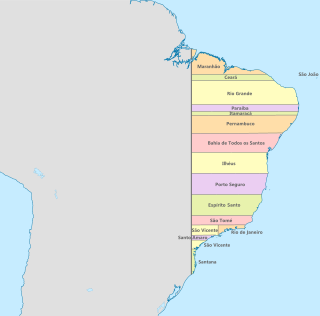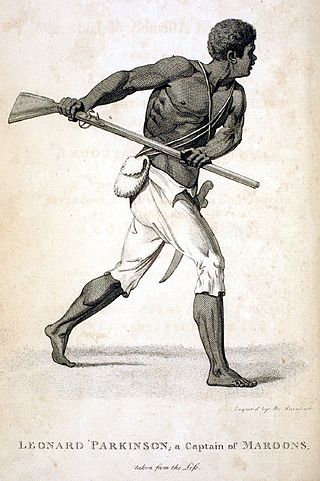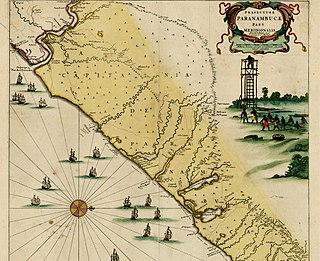Related Research Articles

The globalAfrican diaspora is the worldwide collection of communities descended from people from Africa, predominantly in the Americas. The African populations in the Americas are descended from haplogroup L genetic groups of native Africans. The term most commonly refers to the descendants of the native West and Central Africans who were enslaved and shipped to the Americas via the Atlantic slave trade between the 16th and 19th centuries, with their largest populations in the United States, Brazil, and Haiti. However, the term can also be used to refer to African descendants who immigrated to other parts of the world consensually. Some scholars identify "four circulatory phases" of this migration out of Africa. The phrase African diaspora gradually entered common usage at the turn of the 21st century. The term diaspora originates from the Greek διασπορά which gained popularity in English in reference to the Jewish diaspora before being more broadly applied to other populations.

Colonial Brazil comprises the period from 1500, with the arrival of the Portuguese, until 1815, when Brazil was elevated to a kingdom in union with Portugal. During the 300 years of Brazilian colonial history, the main economic activities of the territory were based first on brazilwood extraction, which gave the territory its name; sugar production ; and finally on gold and diamond mining. Slaves, especially those brought from Africa, provided most of the workforce of the Brazilian export economy after a brief initial period of Indigenous slavery to cut brazilwood.

A quilombo is a Brazilian hinterland settlement founded by people of African origin, and others sometimes called Carabali. Most of the inhabitants of quilombos, called quilombolas, were maroons, a term for escaped slaves.

Zumbi, also known as Zumbi dos Palmares, was a Brazilian quilombola leader and one of the pioneers of resistance to slavery of Africans by the Portuguese in colonial Brazil. He was also the last of the kings of the Quilombo dos Palmares, a settlement of Afro-Brazilian people who liberated themselves from enslavement in the present-day state of Alagoas, Brazil. He is revered in Afro-Brazilian culture as a symbol of African freedom.

Maroons are descendants of Africans in the Americas and Islands of the Indian Ocean who escaped from slavery and formed their own settlements. They often mixed with indigenous peoples, eventually evolving into separate creole cultures such as the Garifuna and the Mascogos.

Palmares, or Quilombo dos Palmares, was a quilombo, a community of escaped slaves and others, in colonial Brazil that developed from 1605 until its suppression in 1694. It was located in the captaincy of Pernambuco, in what is today the Brazilian state of Alagoas. The quilombo was located in what is now the municipality of União dos Palmares.

African Burial Ground National Monument is a monument at Duane Street and African Burial Ground Way in the Civic Center section of Lower Manhattan, New York City. Its main building is the Ted Weiss Federal Building at 290 Broadway. The site contains the remains of more than 419 Africans buried during the late 17th and 18th centuries in a portion of what was the largest colonial-era cemetery for people of African descent, some free, most enslaved. Historians estimate there may have been as many as 10,000–20,000 burials in what was called the Negroes Burial Ground in the 18th century. The five to six acre site's excavation and study was called "the most important historic urban archaeological project in the United States." The Burial Ground site is New York's earliest known African-American cemetery; studies show an estimated 15,000 African American people were buried here.

The Black Seminoles, or Afro-Seminoles, are an ethnic group of mixed Native American and African origin associated with the Seminole people in Florida and Oklahoma. They are mostly blood descendants of the Seminole people, free Africans, and escaped former slaves, who allied with Seminole groups in Spanish Florida. Many have Seminole lineage, but due to the stigma of having mixed origin, they have all been categorized as slaves or freedmen in the past.
The mocambos were village-sized communities mainly of runaway slaves in colonial Brazil, during Portuguese rule.

A quilombola is an Afro-Brazilian resident of quilombo settlements first established by escaped slaves in Brazil. They are the descendants of Afro-Brazilian slaves who escaped from slave plantations that existed in Brazil until abolition in 1888. The most famous quilombola was Zumbi and the most famous quilombo was Palmares. Many quilombolas live in poverty.

Slavery in Brazil began long before the first Portuguese settlement. Later, colonists were heavily dependent on indigenous labor during the initial phases of settlement to maintain the subsistence economy, and natives were often captured by expeditions of bandeirantes. The importation of African slaves began midway through the 16th century, but the enslavement of indigenous peoples continued well into the 17th and 18th centuries. Europeans and Chinese were also enslaved.
There were significant slave revolts in Brazil in 1798, 1807, 1814 and the Malê Revolt of 1835. The institution of slavery was essential to the export agriculture and mining industries in colonial Brazil, its major sources of revenue. A marked decrease in the Indian population due to disease necessitated the importation of slaves early in the colonial history of Brazil with African slaves already being enslaved in greater amounts than Indian slaves on sugar plantations in the Bahia region by the end of the 1500s. A gold and diamond boom in the interior of Brazil in the mid-eighteenth century precipitated a significant increase in the importation of African slaves.
For a history of Afro-Caribbean people in the UK, see British African Caribbean community.
Barbara J. Heath is a professor in the Department of Anthropology at The University of Tennessee, Knoxville who specializes in historical archaeology of eastern North America and the Caribbean. Her research and teaching focus on the archaeology of the African diaspora, colonialism, historic landscapes, material culture, public archaeology and interpretation, and Thomas Jefferson.

Slavery in Latin America was an economic and social institution that existed in Latin America before the colonial era until its legal abolition in the newly independent states during the 19th century. However, it continued illegally in some regions into the 20th century. Slavery in Latin America began in the pre-colonial period when indigenous civilizations, including the Maya and Aztec, enslaved captives taken in war. After the conquest of Latin America by the Spanish and Portuguese, of the nearly 12 million slaves that were shipped across the Atlantic, over 4 million enslaved Africans were brought to Latin America. Roughly 3.5 million of those slaves were brought to Brazil.

Slavery in Cuba was a portion of the larger Atlantic Slave Trade that primarily supported Spanish plantation owners engaged in the sugarcane trade. It was practised on the island of Cuba from the 16th century until it was abolished by Spanish royal decree on October 7, 1886.

The Valongo Wharf (Portuguese: Cais do Valongo) is an old dock located in the port area of Rio de Janeiro, between the current Coelho e Castro and Sacadura Cabral streets. Built in 1811, it was the site of landing and trading of enslaved Africans until 1831, with the blockade of Africa banning the Atlantic slave trade to Brazil.
The word Nagos refers to all Brazilian Yoruba people, their African descendants, Yoruba myth, ritual, and cosmological patterns. Nagos derives from the word anago, a term Fon-speaking people used to describe Yoruba-speaking people from the kingdom of Ketu, Toward the end of the slave trade in the 1880s, the Nagos stood out as the African group most often shipped to Brazil. The Nagos were important to the history of the slave trade at that time in the 19th century, as Brazil requested more enslaved persons as demand for products from this region grew and harsh conditions on plantations entailed a high turnover.
Newton Slave Burial Ground is an industrial heritage site and informal cemetery in Barbados. It was used by people enslaved at the adjacent Newton Plantation. The site has been owned by the Barbados Museum & Historical Society since 1993. It has been subject to excavations since the 1970s, which have produced information regarding slave lifeways including resistance, health, and culture.
References
- 1 2 3 4 5 6 7 8 9 Singleton, Theresa (2010). "African Diaspora in Archaeology". In Olaniyan, Tejumola; Sweet, James (eds.). The African Diaspora and The Disciplines. Bloomington, Ind : Indiana University Press. pp. 119–134. ISBN 9780253354648.
- ↑ Fennell, Christopher (2020). "African Diaspora Archaeology". In Smith, Claire (ed.). Encyclopedia of Global Archaeology (2nd ed.). Springer Cham. pp. 58–59. ISBN 978-3-030-30018-0.
- ↑ McGhee, Fred (2007). "Maritime Archaeology and the African Diaspora". In Ogundiran, Akinwumi; Falola, Toyin (eds.). Archaeology of Atlantic Africa and the African diaspora. Blacks in diaspora. Indianapolis: Indiana university press. pp. 384–393. ISBN 978-0-253-34919-4.
- ↑ Funari, Pedro Paulo A.; Orser, Charles E. (2015). "Archaeology, Slavery, and Marronage: A Complex Relationship". In Funari, Pedro Paulo A.; Orser, Charles E. (eds.). Current perspectives on the archaeology of African slavery in Latin America. Springer briefs in archaeology. New York: Springer. pp. 1–4. ISBN 978-1-4939-1264-3.
- 1 2 3 La Rosa Corzo, Gabino (2010). "The Archaeology of Escaped Slaves". In Kepecs, Susan M.; Curet, L. Antonio; La Rosa Corzo, Gabino (eds.). Beyond the blockade: new currents in Cuban archaeology. Caribbean archaeology and ethnohistory. Tuscaloosa: University of Alabama Press. pp. 126–141. ISBN 978-0-8173-8492-0.
- ↑ Funari, Pedro; Ferreira, Lúcio (2016). "Historical Archaeology Outlook: A Latin American Perspective". Historical Archaeology. 50 (3): 100–107. doi:10.1007/BF03377336. ISSN 0440-9213 – via Springer Complete Journals.
- ↑ Funari, Pedro (2007). "The Archaeological Study of the African Diaspora in Brazil". In Ogundiran, Akinwumi; Falola, Toyin (eds.). Archaeology of Atlantic Africa and the African diaspora. Blacks in diaspora. Indianapolis: Indiana university press. pp. 355–371. ISBN 978-0-253-34919-4.
- ↑ Lima, Tania Andrade (2020-10-01). "Valongo: An Uncomfortable Legacy". Current Anthropology. 61 (S22): S317–S327. doi:10.1086/709820. ISSN 0011-3204.
- ↑ Jane Berman, Mary; Febles, Jorge; Gnivecki, Perry (2005). "The Organization of Cuban Archaeology". In Curet, L. Antonio; Dawdy, Shannon Lee; La Rosa Corzo, Gabino (eds.). Dialogues in Cuban Archaeology. Society for American archaeology. Tuscaloosa: The university of Alabama press. p. 48. ISBN 978-0-8173-1464-4.
- ↑ La Rosa Corzo, Gabino (2005). "Subsistence of Cimarrones: An Archaeological Study". In Curet, L. Antonio; Dawdy, Shannon; La Rosa Corzo, Gabino (eds.). Dialogues in Cuban archaeology. Tuscaloosa, Ala: Univ. of Alabama Press. pp. 163–180. ISBN 978-0-8173-1464-4.
- ↑ Weaver, Brendan J. M.; Fhon Bazán, Miguel A.; Santana Quispe, Lady (2022). "Heritage and the Archaeology of Afro-Peru: Community Engagement in the Valleys of Nasca". Historical Archaeology. 56 (1): 131–152. doi:10.1007/s41636-021-00309-0. ISSN 0440-9213. PMC 8906358 . PMID 35287280.
- 1 2 Ferguson, Leland (1992). Uncommon ground: archaeology and early African America, 1650 - 1800. Washington, D.C: Smithsonian Institution Press. pp. xxxv–xxxix. ISBN 978-1-56098-058-2.
- ↑ Agbe-Davies, Anna (2007). "Practicing African American Archaeology in The Atlantic World". In Ogundiran, Akinwumi; Falola, Toyin (eds.). Archaeology of Atlantic Africa and the African diaspora. Blacks in diaspora. Indianapolis: Indiana university press. pp. 413–425. ISBN 978-0-253-34919-4.
- ↑ Orser Jr., Charles (2023). Living ceramics, storied ground : a history of African American archaeology. Gainesville : University Press of Florida. pp. 5–20. ISBN 9780813069791.
- ↑ Leone, Mark P.; LaRoche, Cheryl Janifer; Babiarz, Jennifer J. (2005-10-01). "THE ARCHAEOLOGY OF BLACK AMERICANS IN RECENT TIMES". Annual Review of Anthropology. 34 (1): 575–598. doi:10.1146/annurev.anthro.34.081804.120417. ISSN 0084-6570.
- ↑ Blakey, Michael L. (2020-10-01). "Archaeology under the Blinding Light of Race". Current Anthropology. 61 (S22): S183–S197. doi: 10.1086/710357 . ISSN 0011-3204.
- ↑ Blakey, Michael L. (2010). "African Burial Ground Project: paradigm for cooperation?". Museum International. 62 (1–2): 61–68. doi:10.1111/j.1468-0033.2010.01716.x. ISSN 1350-0775.